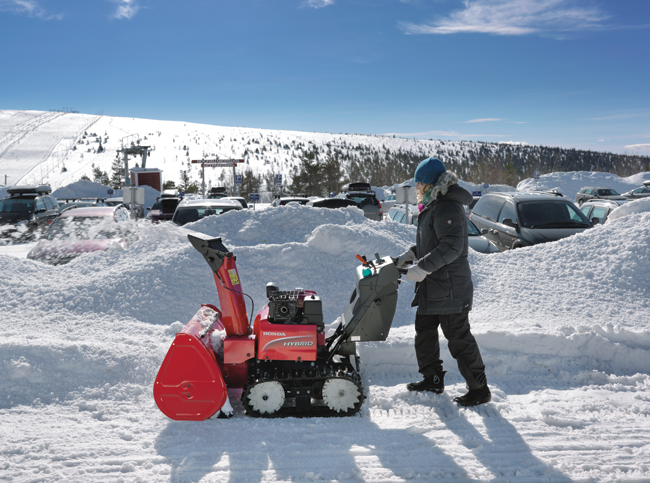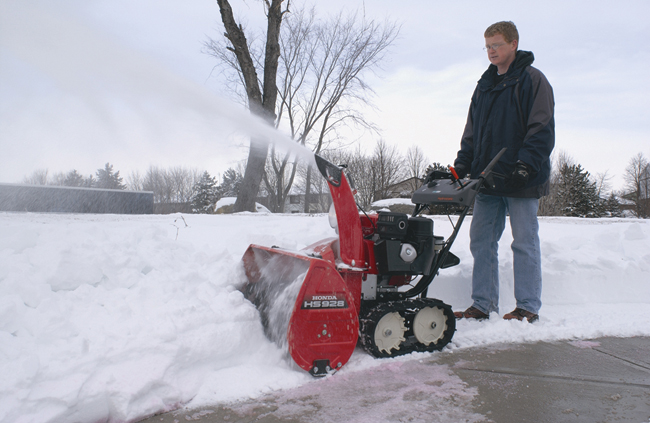A Right-Sized Snowblower
Regardless of the mild winter last season, the reality of the situation is that many parts of the country will have to battle some significant snowfalls. When it comes to snow removal for commercial applications, selecting the right snowblower is critical for any seasonal operation. One of the most important guidelines for purchasing equipment is to ask the right questions before adding or replacing equipment on any jobsite — a practice that can save both time and money. Snowblowers are no exception. According to Tom Pernice, product marketing manager at Honda Power Equipment, getting the most out of any snowblower investment begins with addressing some fundamentals. The following commentary addresses some important factors contractors and consumers alike should consider when choosing a snowblower.
The Smart Start
The smart snowblower purchase starts with knowing your needs and knowing not to overbuy. In other words, don’t purchase the largest, most powerful model available without first considering the terrain and size of the area to be cleared.

“On average, single-stage snow throwers are the right choice for maintaining paved driveways and walkways and where snowfalls average less than 12 in.,” explains Pernice.
Single-stage machines use a high-speed impeller to collect the snow which is then moved out of the snow thrower through a discharge chute. The rotating impeller also provides forward propulsion to minimize operator effort.
“While Honda produces a number of different snowblowers for commercial and consumer applications, our single-stage HS520 model, for instance, with a 20-in. clearing width, is capable of throwing as much as to 55 tons of snow per hour over distances of up to 26 ft,” says Pernice. “It can easily clear a standard two-car driveway and sidewalks for most homes.”
By comparison, contractors in charge of heavy-duty snow removal, like commercial parking lots and roadways, should investigate larger, two-stage models capable of clearing bigger paths.

“The self-propelled, two-stage snowblower is the better option for harsher environments where more aggressive snow clearing is routine. Two components work to collect and throw snow in a two-stage blower — an auger and a high-speed impeller,” says Pernice. “Other considerations are ease of use of the controls and the ability to adapt to varying snow conditions. For example, larger snowblowers come available in wheel or track driven models [with or without electric start] and offer exclusive features including single-lever control hydrostatic transmissions that easily adjust forward and reverse ground speed.”
Pre-Purchase Questions and Answers
A number of other questions are important to ask before making a snowblower purchase. Pernice provides answers to some of the most common queries surrounding the use of a model for commercial applications.
The starting point: What type of surface needs to be cleared?
When it comes to snow removal, knowing what surface you are about to tackle is key; these surfaces, for the most part, can be broken down into three categories:
- Concrete or asphalt.
- Gravel or mixed composite.
- Commercial flat roofs (keep in mind some roofs are best cleared using adjustable head track drive models).
For commercial snow removal applications, is a track drive model preferred over a wheel model?
Two-stage machines are self-propelled, featuring large wheels or track drives. Track drive snowblowers offer superior traction in any snow condition. These models also provide exceptional clearing ability and are preferable for clearing packed snow as well as for clearing commercial flat roofs without damage. Multi-position, adjustable heads with serrated augers on these snowblowers can be set to drive down into hard packed and frozen packed snow — resulting in the ability to clear large areas with ease. Wheel models, on the other hand, are somewhat easier to turn and maneuver but may require additional chains for improved traction. Contractors can consider a wheel model if hard-packed, heavily crusted snow is not a concern.
How large of an area needs to be cleared?
A snowblower model equipped with a larger clearing width makes faster work of clearing the area in question. As a general rule of thumb, consider a two-stage snowblower for larger areas, but before you buy, do the math. For example, when considering a standard 4-ft walkway, a 24-in. clearing width machine will require one round trip to clear the area, while a larger 32-in. clearing width machine would require the same time, providing no advantage. And, look beyond the expected. Don’t forget about narrow or tight spaces that need clearing, as larger units may not fit through customer gates or smaller walkways.
How does the throwing distance of a snowblower factor into model selection?
First and foremost, operators should evaluate snowblower models that offer greatest control over the distance and direction of blown snow. This increased control can reduce time and effort required to clear large commercial areas. Honda snowblowers, for example, are capable of clearing from 46.3 to 83 tons of snow per hour (up to 62 ft) depending on the model and snow conditions.

How important is ease of operation? Are there particular features to look for?
Ease of operation is very important, and it is directly related to the amount of time it takes to complete the job. Operators should be particularly mindful of the control panel on the model, knowing that ergonomically designed controls, especially ones for the transmission, throttle and discharge chute, contribute to simplified operation. Other key features related to ease of operation include:
- Ease of changing speed and direction.
- Ease of adjusting snow discharge distance and direction.
- Interlocking drive and auger control for single-handed operation.
- Ease of starting with or without electric start; remember, snowblowers that use 120-volt electric start require an electrical outlet that is generally not readily available when the machine is in use and away from the storage area.
- Adjustability of head (track drive models).
- Ease of refueling.
How much is the average investment in a snowblower?
Those looking to purchase a snowblower can expect to spend anywhere in the approximate range of $400 to $3,500, depending on the model’s features and capabilities. Honda Power Equipment, for example, markets a complete line of snowblowers (11 different models in five different series) for commercial and consumer applications. The Honda single-stage HS520 models are available starting at $729; the larger, more powerful two-stage HS1332 models are priced beginning at an MSRP of $3,189.
After selecting and purchasing the model best suited for the application, only snow is needed to get started. And, depending on the part of the country, this time frame can be as early as October and as late as the following April. Knowing that the snowfall season can span as many as six months, it’s best to get your new snowblower ready now.
Sara Pines works in public relations with American Honda Motor Co., based in Alpharetta, Ga.
